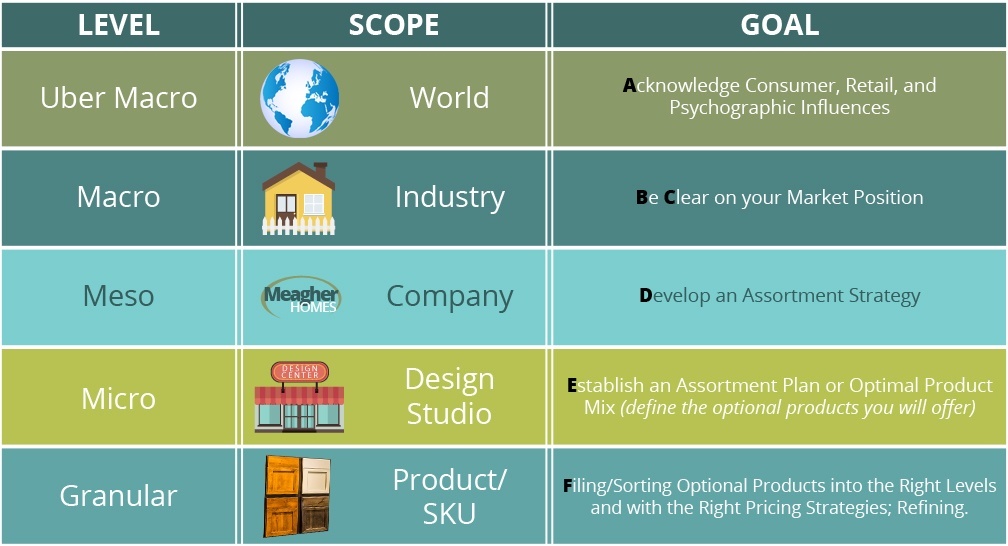Successful retailers spend a massive amount of time strategically defining their “Product Assortment” aka the products they sell in their stores.
They have a clear, updated understanding of their competitor’s Product Assortments and, very specifically, how they want to differ from that.
They study science and theory such as how quantity of choice affects decision-making , how to employ psychological pricing strategies to influence customer determination of product value, and how to maximize the return on investment of every square foot of their store.
They constantly analyze sales data (not just the number of sales but WHY something is selling or not selling), and have programs in place to methodically adjust as needed.
The process for most builders, however, is vastly different. They likely started off ,many years ago, offering some finish products (perhaps cabinet, counter , flooring, lighting, and plumbing choices), and then by a process we could call organic, or haphazard, have added more and more choices and deleted some along the way.
Ask yourself this question: What was the catalyst for the last time you revamped any or all of your Optional Product Assortment? Some answers might be: a change in a key supplier, the building of a new design studio environment (forcing a review of samples), recommendations from one or more of our suppliers, the desire to add a few more modern products in a few categories, perhaps even the introduction of a new type of architectural product.
Not many builders have a top-down driven mandate to create a strategically-derived Product Assortment. Not many builders have a written, team-generated Options Strategy, aligned with their brand position, and designed to maximize per-home revenue and customer satisfaction. Not many builders have performed exhaustive research into why certain products are selling, and only some have a deep understanding of the competitive market value of the products that are offered in their stores.
A huge opportunity lies in the gap between what DOES occur and what SHOULD occur.
The attached chart represents a high-concept blueprint for creating a comprehensive, strategic approach to your Included and Optional Product Assortment.
At the Uber Macro Level of The World, you should take into account the consumer, retail, and psychographic influences that affect your business today.
At the Macro Level, of Our Industry, you should have a crystal clear understanding of the competitive landscape within which you operate so that your marketing messages attract a buyer who is inherently interested in the scope of choice you will offer them, and so that you don’t disappoint your buyers, send mixed messages diluting your brand image, or leave money on the table.
At the Meso Level of Uour Company, it’s about making sure that all departments are aligned with this vision, which will then drive the Assortment Strategy decisions, with an execution plan in place to overcome the operational challenges and maximize the opportunities.
Taking all this into account, at the Micro Level of your Design Studio, it’s about determining the specific skus which will comprise your Product Assortment.
And at the Granular Level of the Product/Sku, it’s about sorting that product into option levels and applying some psychological pricing strategies (like any good retailer does) to influence customer perception of value.
Some key takeaways here are clarity and control. You, as the builder, should be driving and controlling all of these decisions in a macro to micro level approach that produces significant results which can be measured and improved. Again and again. Trends move faster than ever before, and will continue to do so. Now is the time to truly create a Product Assortment Strategy, providing a solid foundation which can be easily updated as needed.
The lack of a clear focus in this area often results in trying to be all things to all people, resulting in confusion, misalignment, missed opportunities, and missed revenue.
For more on this topic, join us at our 2015 National Design Studio Conference, Cash By Design, on September 30and October 1, in Philadelphia…where we’ll be spending a full day on this topic, in an expanded version of the #1 Rated Seminar at IBS 2015. We’ll start with our guest speaker, Al Trellis, teaching strategies and theories for a strategically-derived assortment of floorplans, elevations, and homesites and then moving into 10 strategies and over 30 secrets for executing an intelligent, retail-oriented Product Assortment of Included and Optional Features…plus updated trends in major product categories from some of the industry’s top experts. And that’s just Day One!
If you want to get strategic about your included and optional features, and make 2015 the year you really focus on design studio revenue, you’ll want to join us for a groundbreaking, information-packed program.

